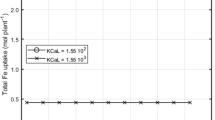Summary
Laboratory incubation studies on the reactions of Fe-DTPA, Fe-EDTA, Fe-citrate and Fe-fulvate with a calcareous soil indicated that Fe3+ was very rapidly displaced by Ca2+, Mg2+, Zn2+ and Cu2+ ions. The displacement of iron was in the reverse order of the stability of the Fe-chelates. The activity of Fe3+, Ca2+, Mg2+, Zn2+ and Cu2+ tended to attain a constant value with time. Application of chelating agents to a calcareous soil mobilized different amounts of iron as defined by their relative stability and cation competition. The degree of mobilization increased with increasing levels of applied chelating agents. A significant negative correlation (r = −0.77)* was observed between pH and DTPA-extractable iron. Results of greenhouse experiment showed significant increase in the dry matter yield and iron uptake by corn plants upon application of iron-chelates. The chelates enhance the uptake of both native and applied sources. The effectiveness of the chelates used was in the order of their capacity to maintain iron in soluble form in the soil solution. These results suggest that iron nutrition of plants in calcareous soils can be effectively regulated by the application of iron chelated by natural or synthetic water-soluble chelating agents.
Similar content being viewed by others
References
Brown, J. C., Tiffin, L. O., Specht, A. W. and Resnicky, J. W., Stability and concentration of metal chelates, factors in iron chlorosis of plants. Agron. J.53, 85–90 (1961).
Lindsay, W. L., Hodgson, J. F. and Norvell, W. A., The physico-chemical equilibrium of metal chelates in soils and their influence on the availability of micronutrient cations. Intern. Soc. Soil Sci. Trans. Comm. II and IV (Aberdeen, Scotland) pp. 303–16(1967).
Lindsay, W. L. and Norvell, W. A., Equilibrium relationships of Zn2+, Fe3+, Ca2+ and H+ with EDTA and DTPA in soils. Soil Sci. Soc. Am. Proc.33, 62–68 (1969).
Norvell, W. A., Equilibrium of metal chelates in soil solution.In Micronutrients in Agriculture. Soil Sci. Soc. Am. Inc. pp. 115–35 (1972).
Norvell, W. A. and Lindsay, W. L., Reactions of EDTA chelates of iron, zinc, copper and manganese with soils. Soil Sci. Soc. Am. Proc.33, 86–91 (1969).
Norvell, W. A. and Lindsay, W. L., Reactions of DTPA chelates of iron, zinc, copper and manganese with soils. Soil Sci. Soc. Am. Proc.36, 778–83 (1972).
Wallace, A., Shanon, L. M., Lunt, O. R. and Impey, R. L., Some aspects of the use of metal chelates as micronutrient fertilizer sources. Soil Sci.84, 27–41 (1957).
Author information
Authors and Affiliations
Rights and permissions
About this article
Cite this article
Singh, R., Sinha, M.K. Reactions of iron chelates in calcareous soil and their relative efficiency in iron nutrition of corn. Plant Soil 46, 17–29 (1977). https://doi.org/10.1007/BF00693111
Received:
Issue Date:
DOI: https://doi.org/10.1007/BF00693111




